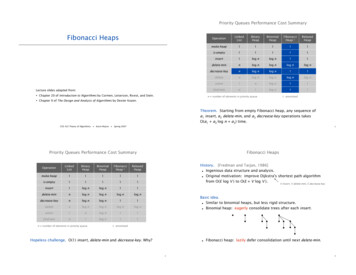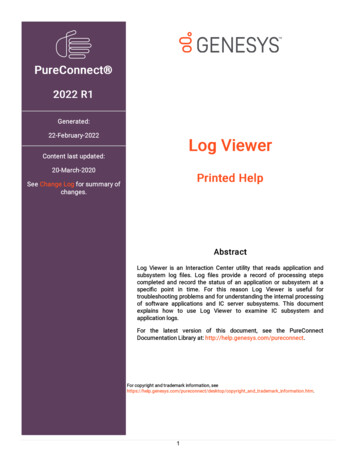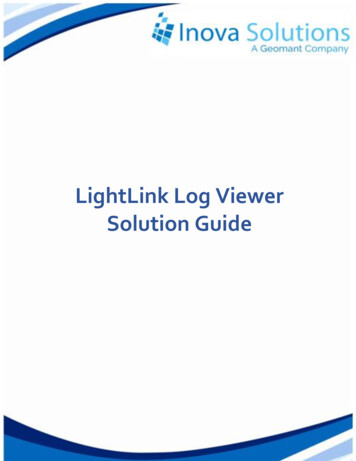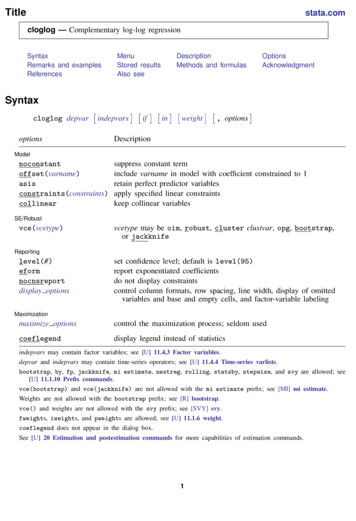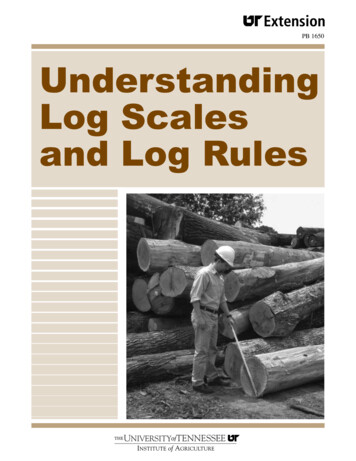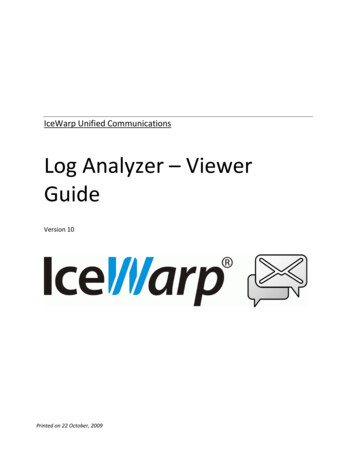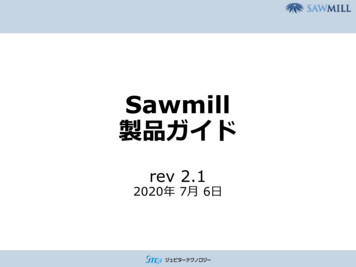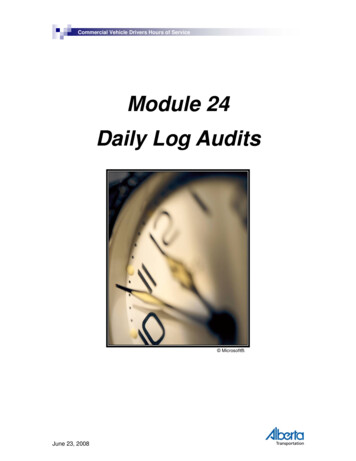
Transcription
Commercial Vehicle Drivers Hours of ServiceModule 24Daily Log Audits Microsoft .June 23, 2008
Commercial Vehicle Drivers Hours of Service Microsoft .Things to think about Motor carriers and Carrier Services’ Investigators areresponsible for ensuring that drivers operate incompliance with the Federal Commercial VehicleDrivers Hours of Service Regulations.Motor carriers must monitor each driver to ensurecompliance with the Regulations. If a motor carrier failsto prevent a driver violation, the motor carrier can beheld liable for the actions of the driver.Carrier Services’ Investigators monitor driver complianceby conducting daily log audits. If an investigator findsa violation, an investigator can lay a charge or anadministrative penalty can be levied against the motorcarrier.What are the motor carrier’s responsibilities?What is a daily log audit?What will I learn in this module?;Motor carrier responsibilities;Daily log auditsModule 24: Daily Log Audits2
Commercial Vehicle Drivers Hours of ServiceWhat are the motor carrier’s responsibilities? Legislative References:-Federal Commercial Vehicle Drivers Hours of Service Regulations(SOR/2005-313) Section 85 Distribution and Keeping of Daily Logs-Federal Commercial Vehicle Drivers Hours of Service Regulations(SOR/2005-313) Section 87 Monitoring by Motor Carriers-Federal Commercial Vehicle Drivers Hours of Service Regulations(SOR/2005-313) Section 99 Production of Daily Logs and SupportingDocuments-Federal Commercial Vehicle Drivers Hours of Service Regulations(SOR/2005-313) Schedule 3 ReceiptMotor carriers are responsible for the following with respect to daily logs: Distribute and keep daily logs Prevent daily log tampering Monitor driver compliance with the Regulations Produce daily logs and supporting documents for inspectionDistribute and Keep Daily LogsThe Federal Commercial Vehicle Drivers Hours of Service Regulations specifythat a motor carrier must do the following: Deposit the daily logs and supporting documents at its principal placeof business within 30 days after receiving them from the driver Keep the daily logs and supporting documents in chronological orderfor each driver for a minimum of 6 monthsModule 24: Daily Log Audits3
Commercial Vehicle Drivers Hours of ServicePrevent Daily Log TamperingMotor carriers must ensure that there is no tampering to daily logs. This meansthat no one can alter a daily log. If a motor carrier employee (i.e., Safety Officer)finds an error on a daily log and wants to “correct” a log, the officer must copy thelog and edit the copy. The employee cannot alter the original record because itis a legal document. This also applies to electronic or scanned logs. Microsoft .Monitor Driver Compliance with the RegulationsMotor carriers are liable for the actions of their employees even if the carriercontends that it did not require or permit the violations to occur. Neither intent tocommit, nor actual knowledge of a violation is a necessary element of liability.Carriers “permit” violations of the Regulations by their employees if they fail tohave management systems in place that effectively prevent such violations.One of the most effective ways to monitor driver compliance is for the motorcarrier to conduct an internal daily log audit. This daily log audit needs to includethe following: Verify that all drivers have a record for all calendar days (Note: seeModule 17 regarding the option for recording multiple days off-duty ona single log) Check all drivers to ensure that drivers apply the Regulations to allroads, both public and private (forestry roads), as well as waterways(ferries) in Canada Check all drivers for all form and manner compliance (i.e. name, date,etc.) Check all drivers in detail at least once a year for fatigue-relatedviolations (i.e., driving over hours, two logs for 1 day, false logs, etc.)Module 24: Daily Log Audits4
Commercial Vehicle Drivers Hours of ServiceModule 24: Daily Log Audits5
Commercial Vehicle Drivers Hours of Service Have written policies in their Safety program that address the following: Use independent (i.e., that the driver does not create or canmodify) supporting documents to verify logs (e.g. fuel receipts,tach cards, bills of lading with shipping times, etc.) Check new drivers / dispatchers / safety staff more frequentlyuntil carrier is satisfied that they understand the rules Check drivers / dispatchers / safety staff with previouslyidentified problems more frequently until carrier believes theynow are following the rules Check a random percentage of all drivers / dispatchers / safetystaff at least monthly (e.g. 10% of drivers monthly will ensure alldrivers are selected at least yearly) Record dates on which non-compliance occurred and recorddate that the motor carrier issued a notice of non-compliance Identify who is responsible for performing these checks,preparing the summary reports, taking actions, etc. and ensurethat these employees have the necessary skills and knowledge Address all identified deficiencies with individual staff, takingappropriate actions (e.g. re-training or discipline) anddocumenting the actions taken in the staff's file Prepare a summary report at least monthly of the findings of thisinternal audit, the corrective actions taken; provide this report atleast to carrier's senior management; and retain all such reportsfor at least 6 months (longer is recommended)It is the motor carrier’s responsibility to ensure that the all drivers, including newdrivers, comply with the Regulations. If the motor carrier cannot obtain copies ofthe daily logs from the previous carrier, at the very least, the motor carrier shouldobtain a signed statement from the driver that specifies the total on-duty and offduty hours for the previous 14 days.Module 24: Daily Log Audits6
Commercial Vehicle Drivers Hours of ServiceProduce Daily Logs and Supporting Documents for InspectionAt the request of and at a location specified by an investigator, a motor carriermust immediately make available for inspection the following: Daily logs, supporting documents and other relevant records. A list ofsupporting documents is on page 7.A duty status record for a radius exemption driver (refer to Module 18)is a relevant record. An investigator / inspector can request that therecord be sent or faxed immediately to a Vehicle Inspection Station,government office, etc. during a carrier’s normal business hours (i.e.,some carriers may operate hours other than 9:00 am – 5:00 pm). Any permit under which the driver is operating or has been operatingThe investigator will do the following: Immediately return the permit if it is still a current permit. Theinvestigator can make a copy of the permit, if required. Give the carrier a receipt for any expired permit as well as the dailylogs, supporting documents and other relevant records. A samplereceipt is on page 8. Return the expired permits, daily logs, supporting documents and otherrelevant records within 14 days after receiving themAs discussed in Module 21, investigators have the legal authority to enter amotor carrier’s premises to inspect daily logs, supporting documents and otherrelevant records. No carrier staff can obstruct or hinder, or knowingly make anyfalse or misleading statements whether orally or in writing to an investigator. Microsoft .Module 24: Daily Log Audits7
Commercial Vehicle Drivers Hours of ServiceExamples of Supporting Documents for a Motor CarrierBills of ladingLessor settlement sheetsCarrier profilesOver/short and damage reportsFreight billsAgricultural inspection reportsDispatch recordsCVSA reportsDriver call-in recordsAccident reportsGate record receiptsTelephone billing statementsWeight/Scale ticketsCredit card receiptsFuel receiptsDriver fax reportsFuel billing statementsOn-board computer reportsToll receiptsBorder crossing reportsInternational registration plan receiptsCustom declarationsInternational fuel tax agreementreceiptsTraffic citationsTrip permitsPort of entry receiptsCash advance receiptsDelivery receiptsLumber receiptsInterchange and inspection reportsModule 24: Daily Log AuditsOverweight/oversize reports andcitationsElectronic records stored in computersby a consulting company or serviceproviderOther documents directly related to themotor carrier’s operation which areretained by the motor carrier inconnection with the operation of itstransportation business8
Commercial Vehicle Drivers Hours of ServiceSAMPLE RECEIPTIt is hereby acknowledged that, pursuant to subsection 98(4) or paragraph99(2)(a) of the Commercial Vehicle Drivers Hours of Service Regulations, thefollowing daily logs, supporting documents and other records were provided by(Name of person)At(Number, street, municipality, location, province of motor carrier)On(Day, month, year)Namely(Description of daily logs, supporting documents and records received)Dated at(Municipality, location)On(Day, month, year)Inspector’s signatureModule 24: Daily Log Audits9
Commercial Vehicle Drivers Hours of ServiceWhat is a daily log audit?A daily log audit is a process for testing the accuracy and completeness ofinformation contained in a driver’s daily logs. Carrier Services Investigatorsconduct daily log audits and issue reports on the results of the audit. Microsoft .When conducting a daily log audit, a Carrier Services investigator does thefollowing: Consults with the Manager of Investigations prior to audit start Recognizes that the audit is not a one- or two-day process. A properlycompleted audit of a medium size motor carrier can take up to 39hours and this may occur over several weeks. Confirms the motor carrier’s full legal name, motor vehicle identification(MVID) and National Safety Code (NSC) identification details Gathers all available data on carrier historyModule 24: Daily Log Audits10
Commercial Vehicle Drivers Hours of Service Establishes a game plan prior to meeting with the carrier, including: To whom does the investigator need to talk? What documents are available? What is the carrier’s administrative process?Provides the motor carrier with a detailed description of the auditprocess: Pick sample Obtain driver, vehicle and carrier information Review logs Obtain additional supporting documents Interview staff Review documents Prepare reports Review reports with motor carrier Request carrier response and future commitment Submit final report to supervisor Ensures that the carrier understands that charges may be laid or anAdministrative Penalty may be levied as a result of the audit. Theinvestigator is up front and honest with the carrier. Follows the established document sampling procedures Does not take a sample that will require the use of the carrier’s currentaccounting records as this may disrupt the carrier’s business too much Does not demand records and supporting documents to which theinvestigator has no right. The investigator only needs one or two typesof documents (e.g. fuel statements and bills of lading). An investigatorcan use other types of supporting documents during a re-audit. Obtains the MVID and Operator’s licence of all drivers sampled andchecks the operator's licence status.Module 24: Daily Log Audits11
Commercial Vehicle Drivers Hours of Service Copies two sets of the daily logs, one clean copy initialed and dated forcourt purposes and the second for notes, to accompany theinvestigator’s final report and audit report for carrier’s review. Tests to see if logbook entries look reasonable Does the driver show pre-trip and post-trip inspections? Does the driver show loading and unloading times? Loadsecurity checks? Are most of the log entries recorded on the hour? Are there excessive sleeper berth times? Does the vehicle driven actually have a sleeper berth? Did the driver do any on-duty function on off-duty days such asfueling, loading / unloading, etc.? Are there excessive periods of off-duty time? Did the driver make an unaccounted trip? Is the driver working for more than one carrier (e.g. morecommon for bus drivers)? Is there a co-driver? If so, do the driver’s logs match the codriver’s logs? Does the previous day’s ending odometer reading (or mileage)match with the current day’s starting odometer reading?Completes the “Driver's Hours of Service Worksheets” (CompleteHours of Service in the Audit section of the ARC Program), one foreach driver reviewed. The investigator submits these worksheets withthe Audit report (Complete Audit Report in ARC Program).The ARC (Assessment of Regulatory Compliance) Program is an auditprogram that investigators use to ensure that commercial truck andbus carriers are operating in compliance with current legislation.Investigators use ARC to conduct NSC (National Safety Code) Auditsand Hours of Service Investigations: A NSC Audit is quantifiable, satisfies a national NSC Standard#15, meets the definition of an audit (systematic approach togather information), and includes Hours of Service daily logaudits (i.e., Hours of Service is only one part of a NSC audit).Module 24: Daily Log Audits12
Commercial Vehicle Drivers Hours of Service An Hours of Service Investigation involves the collection of datain response to complaints, poor safety performance, etc. Ratherthan conducting a complete NSC Audit, an investigator canconduct an Hours of Service Investigation using ARC as onetool in the investigative process. The investigation is not asrestrictive as an audit and the investigator has the flexibility toidentify other compliance issues, the cause of non-compliance,etc. that an audit does not allow. Identifies on the worksheet, all hours worked and violations identified Uses the same violation guidelines contained in the ARC Audit Manual Calculates all the daily, work shift and cycle violations Checks off form and manner violations by exception (i.e., marks thoseitems missing on each daily log) If the investigator finds a work shift violation, the investigator notes theshift start and end times adjacent to the dates involved When preparing to complete the worksheets, the investigator arrangesand identifies daily logs and supporting documents alphabetically bydriver. The investigator keeps the information organized. Microsoft .Module 24: Daily Log Audits13
Commercial Vehicle Drivers Hours of ServiceModule Self-Check QuestionsIf you can answer the following questions, you are ready to move to the nextmodule. If you can’t answer the questions, please review the module againbefore continuing.1) Identify the number of days that a motor carrier has to deposit daily logs andsupporting documents at it principal place of business after receiving themfrom a driver.2) Identify the number of months that a motor carrier must keep daily logs andsupporting documents.3) Identify how a motor carrier can prevent tampering to daily logs.4) Identify strategies that a motor carrier can use to monitor driver compliancewith the Regulations.Module 24: Daily Log Audits14
Commercial Vehicle Drivers Hours of Service5) Identify the documents that a motor carrier must make available forinspection.6) Identify what an investigator will do when given documents for inspection.7) Describe a daily log audit. and identify some of the activities that aninvestigator will perform during a daily log audit.8) In the following list, place a check mark beside the activities that aninvestigator will perform during a daily log audit.Consults with the Manager of Investigations prior to audit startRecognizes that the audit is not a one- or two-day processConfirms the motor carrier’s full legal name, motor vehicle identification(MVID) and National Safety Code (NSC) identification detailsGathers all available data on carrier historyEstablishes a game plan prior to meeting with the carrierProvides the motor carrier with a detailed description of the auditprocessEnsures that the carrier understands that charges may be laid or anAdministrative Penalty may be levied as a result of the auditFollows the established sampling proceduresModule 24: Daily Log Audits15
Commercial Vehicle Drivers Hours of ServiceDoes not take a sample that will require the use of the carrier’s currentaccounting records as this may disrupt the carrier’s business too muchDoes not demand records and supporting documents to which theinvestigator has no rightObtains the MVID and Operator’s licence of all drivers sampled andchecks the operator's licence statusCopies two sets of the daily logs, one clean copy initialed and dated forcourt purposes and the second for notes, to accompany theinvestigator’s report and spreadsheet and for carrier reviewTests to see if logbook entries look reasonableCompletes the “Driver's Hours of Service Worksheets” (Complete Hoursof Service in the Audit section of the ARC Program), one for each driverreviewed. The investigator submits these worksheets with the Auditreport (Complete Audit Report in ARC Program)Identifies on the worksheet, all hours worked and violations identifiedUses the same violation guidelines contained in the ARC Audit ManualCalculates all the daily, work shift and cycle violationsChecks off form and manner violations by exception (i.e., marks thoseitems missing on each daily log)If the investigator finds a work shift violation, the investigator notes theshift start and end times adjacent to the dates involvedWhen preparing to complete the worksheets, the investigator arrangesand identifies daily logs and supporting documents alphabetically bydriverModule 24: Daily Log Audits16
Commercial Vehicle Drivers Hours of ServiceAnswers to Module Self-Check Questions1) Identify the number of days that a motor carrier has to deposit daily logs andsupporting documents at it principal place of business after receiving themfrom a driver. Motor carrier has 30 days to deposit daily logs and supportingdocuments at its principal place of business after receiving them2) Identify the number of months that a motor carrier must keep daily logs andsupporting documents. Motor carrier must keep daily logs and supporting documents inchronological order for each driver for a minimum of 6 months3) Identify how a motor carrier can prevent tampering to daily logs. No one can alter a daily log, electronic log or scanned log If a motor carrier employee (i.e., Safety Officer) finds an error on adaily log, the officer must copy the log and edit the copy (cannot alterthe original record because it is a legal document)4) Identify strategies that a motor carrier can use to monitor driver compliancewith the Regulations. Verify that all drivers have a record for all calendar days Check all drivers to ensure that drivers apply the Regulations to allroads, both public and private (forestry roads), as well as waterways(ferries) in Canada Check all drivers for all form and manner compliance (i.e. name, date,etc.) Check all drivers in detail at least once a year for fatigue-relatedviolations (i.e., driving or hours, two logs for 1 day, false logs, etc.) Have written policies in their Safety program that address the following: Use independent (i.e., that the driver does not create or canmodify) supporting documents to verify logs (e.g. fuel receipts,tach cards, bills of lading with shipping times, etc.) Check new drivers / dispatchers / safety staff more frequentlyuntil carrier is satisfied that they understand the rulesModule 24: Daily Log Audits17
Commercial Vehicle Drivers Hours of Service Check drivers / dispatchers / safety staff with previous identifiedproblems more frequently until carrier believes they now arefollowing the rules Check a random percentage of all drivers / dispatchers/ safetystaff at least monthly (e.g. 10% of drivers monthly will ensure alldrivers are selected at least yearly) Record dates on which non-compliance occurred and recorddate that the motor carrier issued a notice of non-compliance Identify who is responsible for performing these checks,preparing the summary reports, taking actions, etc. and ensurethat these employees have the necessary skills and knowledge Address all identified deficiencies with individual staff, takingappropriate actions (e.g. re-training or discipline) anddocumenting the actions taken in the staff's file Prepare a summary report at least monthly of the findings of thisinternal audit, the corrective actions taken; provide this report atleast to carrier's senior management; and retain all such reportsfor at least 6 months (longer is recommended)5) Identify the documents that a motor carrier must make available forinspection. Daily logs, supporting documents and other relevant records Any permit under which the driver is operating or has been operating6) Identify what an investigator will do when given documents for inspection. Immediately return the permit if it is still a current permit Give the carrier a receipt for any expired permit as well as the dailylogs, supporting documents and other relevant records Return the expired permits, daily logs, supporting documents and otherrelevant records within 14 days after receiving them7) Describe a daily log audit. Daily log audit is a process for testing the accuracy and completenessof information contained in a driver’s daily logsModule 24: Daily Log Audits18
Commercial Vehicle Drivers Hours of Service8) In the following list, place a check mark beside the activities that aninvestigator will perform during a daily log audit.;Consults with the Manager of Investigations prior to audit start;Recognizes that the audit is not a one- or two-day process;Confirms the motor carrier’s full legal name, motor vehicle identification(MVID) and National Safety Code (NSC) identification details;Gathers all available data on carrier history;Establishes a game plan prior to meeting with the carrier;;;;;;;;;Provides the motor carrier with a detailed description of the auditprocessEnsures that the carrier understands that charges may be laid or anAdministrative Penalty may be levied as a result of the auditFollows the established sampling proceduresDoes not take a sample that will require the use of the carrier’s currentaccounting records as this may disrupt the carrier’s business too muchDoes not demand records and supporting documents to which theinvestigator has no rightObtains the MVID and Operator’s licence of all drivers sampled andchecks the operator's licence statusCopies two sets of the daily logs, one clean copy initialed and dated forcourt purposes and the second for notes, to accompany theinvestigator’s report and spreadsheet and for carrier reviewTests to see if logbook entries look reasonableCompletes the “Driver's Hours of Service Worksheets” (Complete Hoursof Service in the Audit section of the ARC Program), one for each driverreviewed. The investigator submits these worksheets with the Auditreport (Complete Audit Report in ARC Program)Module 24: Daily Log Audits19
Commercial Vehicle Drivers Hours of Service;Identifies on the worksheet, all hours worked and violations identified;Uses the same violation guidelines contained in the ARC Audit Manual;Calculates all the daily, work shift and cycle violations;;;Checks off form and manner violations by exception (i.e., marks thoseitems missing on each daily log)If the investigator finds a work shift violation, the investigator notes theshift start and end times adjacent to the dates involvedWhen preparing to complete the worksheets, the investigator arrangesand identifies daily logs and supporting documents alphabetically bydriverModule 24: Daily Log Audits20
Commercial Vehicle Drivers Hours of ServiceNotes:Module 24: Daily Log Audits21
Motor carriers must monitor each driver to ensure compliance with the Regulations. If a motor carrier fails to prevent a driver violation, the motor carrier can be held liable for the actions of the driver. Carrier Services' Investigators monitor driver compliance by conducting daily log audits. If an investigator finds
